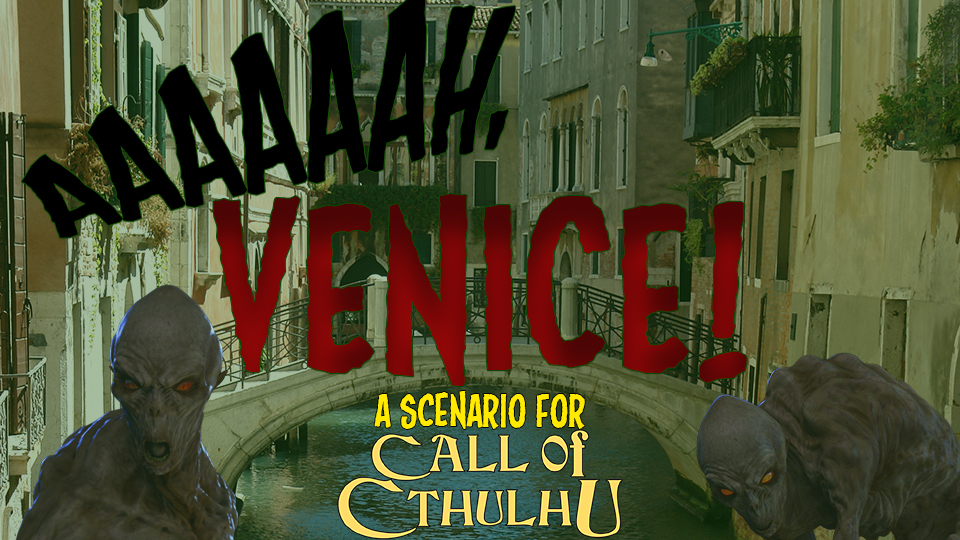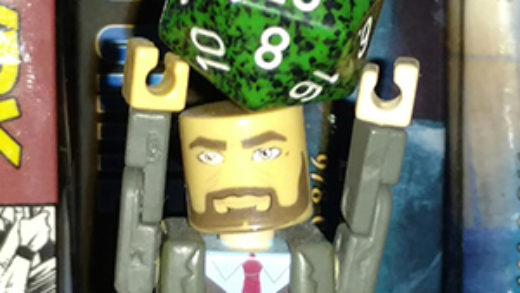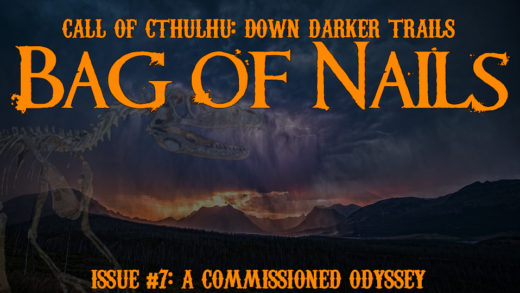Venice, the city of water, the most serene. Those tranquil canals may seem safe on the surface, but they rise and bring with them destruction. This Call of Cthulhu scenario sees investigators in the 1920s fighting against time, tide, and madness.

Introduction
This scenario takes place in Venice, Italy in the late 1920s, after the Great War but before World War II was even conceivable. Investigators may be part of an on-going campaign or this can be a “one shot” with pre-generated PCs who may later serve as NPC advisors or leaders in a World War Cthulhu campaign—should they survive. The adventure incorporates investigation, sanity checks, and physical combat and is best suited for three to six players.
For the Keeper
Francisco Zancani was an art collector and a family man, though his art collection was a bit unusual (and somewhat disturbing). And, as it turns out, his family was also not what he expected. His wife, Caterina was a Deep One hybrid who shed her human form late in life, after birthing and raising their two children.
The Zancani estate was filled with artwork like Théodore Géricault’s Anatomical Pieces, Peter Paul Ruben’s Massacre of the Innocents, Odilon Redon’s Smiling Spider, and sculptures of Grecian, Roman, and Christian monsters. The head of the family loved having guests over and delighted over their disgusted or frightened faces. He had an admiration for storytellers who could weave terror into their works and none fascinated him more than Caterina Sanuto, a commoner who told the most fearful stories of the sea. Francisco was enchanted by her and, after a whirlwind courtship, married her. Shortly after, she gave birth to their first child, a girl they named Zaneta. Two years later, a son: Zusto.
The two children were thin and gangly, but not abnormally so, and for thirteen more years the family lived a relatively normal (if eccentric) life. Then, after a particularly severe seasonal flood (known as acqua alta), a green-yellow mold began to grow along the baseboards of the estate. Nothing Francisco could do seemed to be able to remove the mold—unbeknownst to him, the mold was caused by the initial flaking of skin from his wife and children—and his family members began to display strange behaviors—like eating raw meat, smelling of mold, and murdering household staff. The elder Zancani did his best to hide the terrors from the outside world, but his eccentricity was becoming more and more disturbing. Then, his wife and family transformed into humanoid abominations, shedding their outer skin and breaking through the floorboards by the staircase to escape into the water.
Already slipping into insanity, the transformation of his family pushed Francisco over the edge and he boarded his estate from the outside world, stacked furniture and artwork over the hole in the floor and slit his own throat. This was a month before the investigators arrived. The body of Francisco Zancani was only discovered a week ago, and much of the palazzo has been untouched since then, awaiting more experienced detectives.
It’s late autumn and the Investigators were sent to Venice to aid in art collection and appraisal, but may now have a secondary mission of investigating the home and determining what may have caused the gruesome suicide.
Venice, Late 1920s
Tourism has been a major sector of Venetian industry since the 18th century, but in the 1920s Italy was only just recovering from a financial depression. Assisting on its road to recovery was Prime Minister Benito Mussolini, who declared himself dictator in 1925. During the late 1920s, his leadership was generally well-regarded by leadership in the US and Britain, with US President Roosevelt claiming, “deeply impressed by what he [Mussolini] has accomplished” and British Prime Minister Churchill saying the Italian Fascist movement “rendered a service to the whole world.” Attitudes that would, of course, change during the late 1930s.
During the early 1920s, Venice was re-preparing itself to be a tourist and cultural destination once again, with the Doge’s Palace having been transformed into an art museum in 1923. The populace was kept safe with the Carabinieri, an Italian military force acting as police, regularly patrolling the streets and waterways.
Politics, In My Game‽
How much a Keeper wants to incorporate views of fascism from the time period in comparison today is up to them. While it could make for a unique spin on the session, comparing and contrasting modern attitudes to those of the past, the paragraph on Mussolini and other leadership views in the above was to illustrate that most Investigators of the time would likely not have any qualms about visiting the growing fascist country.
What Brings You To Venice?
The expected method to include the Investigators is that they’re members of The Society for the Exploration of the Unexplained, sent to assist in rare and unusual art recovery for the Venice museum at the newly reformed Doge’s Palace, only to be pulled into the investigation of the Zancani estate.
Some other options for Investigators include:
- The PCs are not members of the Society, but art students on an rare academic trip, traveling through Europe and stopped in Venice to aid the museum in acquisition and identification
- Investigators are Venetians or Italians, detectives with more powers of deduction than standard police specifically assigned to the Zancani case
- The Investigators’ are tourists to Venice, but their presence and general knowledge/experience elicited a call for assistance
Commercial air travel in the late 1920s was rare, and flights to Italy would need to be chartered. If traveling overseas this would require fueling stops, including a stop in Rome. (If the Investigators are Italian detectives, they would likely be coming from Rome). The final terminal would be Venice-Lido Airport. From there, a boat ride (not a gondola) would take the PCs to the grand canal and the city of Venice.
Art Acquisition and Acqua Alta
Guissepe da Cola directs art acquisition for Doge’s Palace, which was turned into a museum in 1923. The head curator is short, thin, and perpetually nervous with affectations of dabbing the sweat from his brow, stroking his beard, or cleaning his glasses. His hands rarely seem to leave his face for long. Prior to the death of Francisco Zancani, there was an arrangement to view some of the art at the Zancani Palazzo as possible donations to the gallery. With the discovery of Francisco’s suicide and his family missing, and also presumed dead, all the art is to be carefully returned to the museum and catalogued. Given that much of the art has been removed from the walls and unceremoniously stacked near the estate’s staircase, it will be a challenge to ensure no additional damage comes to the paintings or statues. As it’s late fall, time is also a factor as the seasonal flooding, or acqua alta, is expected and the art on the floor could be damaged if the flooding is as bad as it was in the year prior. Even if the Investigators are detectives working for the Italian police, they will need to assist in handling the art and will be instructed to take great care with it.
An Inquiry of Suicidal Proportion
If the Investigators have any experience with crime-solving (that is, if they’re members of the Society or are detectives from Rome) they’ll also meet Brigadier Mafeo Barbarigo. The local head of the Carabinieri is broad shouldered and muscular. Physically, the brigadier looks like he could take on the world. His demeanor, however, is of flustered anger, as if he was not prepared to be in a position of leadership. This agitation is exacerbated by the strange situation at the Zancani Palazzo. His own squad refuses to stay in the estate long, claiming fear of plague. As such, little of the estate has actually been investigated and it’s likely that the bodies of Caterina Zancani and her two children still remain in the building. If the Investigators look through the limited reports (written in Italian) they’ll see that little thought has been given to their missing maid or caretaker. If questioned about them, the brigadier will claim that they are of “little consequence” and does not believe they are associated with the death of Francisco or any theft, given how much art and valuables are clearly (if haphazardly) lying around.
Zancani Palazzo
The palazzo is located near the San Marco district along a minor canal. As with most of Venice, the fastest method of travel to the estate is by boat. Whether by water or foot, the smells coming from the home are an assault to the senses: a melange of death, decay, mold, and sewage. Once inside the first floor, the Investigators will find the remains of a once affluent home, now torn apart, with most of the furniture and art crudely crammed in the stairwell. The blood of Francisco Zancani stains the floorboards near center of the main hall—his body removed by the police days ago. A greenish-yellow mold can be found growing in the cracks of the floorboards with mold spores hanging in the air. (Even the most grizzled veterans will likely find the scene disturbing and a Sanity check may be required to not exit the estate to catch one’s breath and recuperate.)

I Collect Mold, Spores, and Fungus
The mold around the baseboards and in the air is relatively harmless in the short-term, but can have negative respiratory effects in the long-term. If too much is inhaled in it will begin to affect the brain and if precautions are not taken CON rolls may be required to fight off sudden mold toxicity; symptoms of which include depression, anxiety, panic, brain fog, insomnia, fatigue, as well as poor concentration and memory. The mold is also “sticky,” and Investigators will need to check and clean their clothes after leaving the estate or risk the mold spreading to future destinations like the museum, Carabinieri headquarters, or being packed in their suitcases.
I Don’t Know Much About Art, But I Know I Don’t Like This
Though some of the art strewn around the stairwell is irreparably damaged, much of the overall damage was limited to restorable scuffs and broken frames. Francisco Zancani delighted in the art of gore, monsters, and horror. Some of the art may have a disturbing impact on Investigators—especially in respect to the real-life horrors around them. Depending on the platform for the game, Keepers may want to search for “disturbing classical art” prior to the scenario to show players (for a quick “starter kit” check out these pages on HuffingtonPost, Mental Floss, and Private Island Party).
Help Never Comes
Once the stairwell is somewhat cleared it will show that the floorboards covered by the art and furniture are shattered, revealing the waters below. Some pieces of art will be floating in the brackish water. If the Investigators go upstairs they’ll discover the mutilated bodies of the elderly, male caretaker and middle-aged, female housekeeper shoved into a closet.
In Too Deep Ones
Once uncovered, the Zancani matron and her children—now ghouls—will climb up from the hole in the floor to challenge (that is, devour) the Investigators. Depending on the state of the PCs and timing of the game, they may slip to the surface under cover of darkness and attempt to lure the Investigators to their demise one at a time by making tiny noises at the edge of an Investigator’s hearing. Alternatively, they can attack as a fast and savage pack, forcing the PCs into an immediate and violent confrontation.
Conclusion
Though the Deep Ones may be vanquished and their remains identified by the wedding band on the ghoul corpse of Caterina their reason for being and origin will remain a mystery. Record of the events may be found in Francisco Zancani’s journal, but it will provide no final answers and Brigadier Mafeo Barbarigo will be quick to bury any mention of supernatural or monsters, re-writing any official reports to point to Francisco as a maniac who murdered his staff, family, and self.
If this scenario is used to set up a framework for a Europe-based game in World War Cthulhu (as was my original intent), any surviving Investigators can become NPCs, put in charge of the younger, newer PC Investigators and using the mannerisms brought forth by the players to give the now-NPCs stronger ties to the players.



Recent Comments